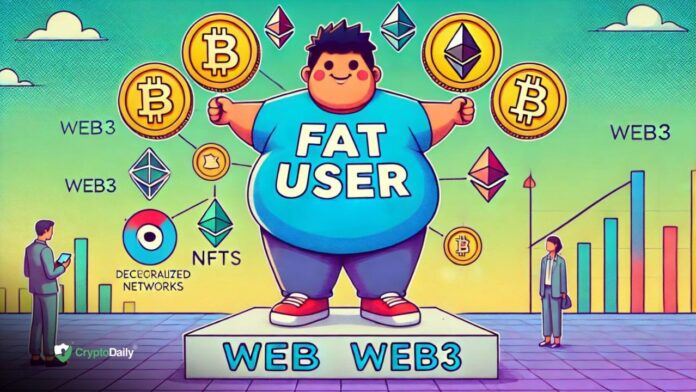In 2016, Joel Monegro introduced the idea of the “Fat Protocols.” According to this theory, value in blockchain ecosystems would accumulate primarily at the protocol layer rather than the application layer.
Essentially, most of the value would go into Native tokens used for Transactions, such as ETH and BNB, as opposed to dApp tokens like $CAKE and $UNI. The more decentralized applications (dApps) built on these platforms, the greater the network effects and demand for the protocol’s native tokens.
This would drive up their value—a reversal from the traditional internet model, in which companies like Facebook capture most of the value while the underlying protocols (e.g., TCP/IP) do not. There are some opposing ideas to Fat Protocol Thesis, one of which was recently discovered via this X post. It proposes a solution called the “Fat User Model”.
The Debate over Value Capture
Despite the compelling nature of the Fat Protocols theory, critics like Pantera Capital argue that value will concentrate at the application layer.
They believe that dApps focused on specific use cases can build deep moats—like liquidity, user experience, and brand loyalty—that allow them to extract significant value.
But What About the Users?
Interestingly, the Fat Protocols and application layer frameworks overlook the most crucial stakeholder in the Web3 economy—the user.
Isn’t the goal of this new financial system to benefit users first and foremost? Yet, they don’t appear in any of these value capture models.
For Web3 to thrive, a fresh approach is needed—one that rewards continuous contributions and reallocates capital to new entrants.
Why the Fat User Idea is Relevant
This is where the Fat User Thesis comes into play. The current value capture models are temporary mistakes that will self-correct, with Web3 users capturing most of the value going forward.
Competition
In a competitive market, value capture is unsustainable as it tends to be competed away via the mercenary capital problem that has plagued the crypto industry for years.
The Web3 ecosystem is highly competitive, with forkable open-source code and numerous L1s, L2s, and dApps to choose from. No single player can dominate for long, making it imperative for protocols and applications to continually innovate and provide value to users.
Low Switching Costs
The concept of self-sovereignty and interoperability implies highly mobile assets. Any token, liquidity provider (LP) position, or user activity can easily transfer to another protocol with minimal switching costs.
This mobility empowers users to choose platforms that offer the best value, further supporting the Fat User Thesis.
Limited Network Effects
Some may argue that the network effects central to the Fat Protocol and application layer are overrated.
With high competition and low switching costs, bootstrapping a network is easier than ever. New networks can quickly gain traction, reducing the barriers to entry and allowing users to reap the benefits of emerging platforms.
Programmable Incentives
Programmable incentives function as switching rewards, generating on-demand network effects for any protocol or dApp. This dynamic creates a more equitable distribution of value, aligning perfectly with the core principles of the Fat User Thesis.
And now, there’s a dApp that focuses on bringing it all together, officially giving life to the Fat User idea.
Nudge Believes It Has the Solution
Web3 needs a catalyst to fuel the Fat User Thesis, and the Nudge team thinks they have it figured out. The project empowers protocols and applications to incentivize—or “nudge”—users to reallocate their assets, liquidity, and activity.
This creates a switching reward that effectively redistributes value from protocols and dAppsto users, providing a scalable customer acquisition funnel and a robust retention mechanism.
Most Nudges will not be one-time occurrences but ongoing incentives, rewarding reallocation over time and considering future users.
This approach is akin to an advertising budget—a recurring expense for off-chain companies—but with the crucial difference that this “advertising budget” directly benefits the end-user, not intermediaries like Google.
Still in the pre-launch phase, Nudge is expected to transform the on-chain economy by reallocating value to users, ultimately expanding the entire ecosystem. By empowering users with programmable incentives, Nudge aligns with the Fat User Thesis and drives a more user-centric Web3 economy.
Fat Users Are the Web3 End Game
The discourse surrounding the Fat User Thesis signifies a paradigm shift in the Web3 ecosystem. By challenging the existing value capture models that predominantly favorprotocols and applications, it advocates for a more user-centric approach that prioritizes users’ needs and contributions.
Platforms like Nudge exemplify how programmable incentives can be harnessed to drive user engagement and ensure equitable value distribution. Web3’s success hinges on its ability to empower users, making them the key beneficiaries of this new financial framework.
By embracing this perspective, the Web3 community can build a thriving, inclusive ecosystem that redefines engagement and value in the digital world.
Disclaimer: This article is provided for informational purposes only. It is not offered or intended to be used as legal, tax, investment, financial, or other advice.
Credit: Source link






















 Bitcoin
Bitcoin  Ethereum
Ethereum  XRP
XRP  Tether
Tether  Solana
Solana  USDC
USDC  Dogecoin
Dogecoin  Cardano
Cardano  Lido Staked Ether
Lido Staked Ether  TRON
TRON  Wrapped Bitcoin
Wrapped Bitcoin  Wrapped stETH
Wrapped stETH  Chainlink
Chainlink  Avalanche
Avalanche  Sui
Sui  Stellar
Stellar  Litecoin
Litecoin  Shiba Inu
Shiba Inu  Toncoin
Toncoin  Hedera
Hedera  LEO Token
LEO Token  USDS
USDS  Hyperliquid
Hyperliquid  Polkadot
Polkadot  WETH
WETH  MANTRA
MANTRA  Bitcoin Cash
Bitcoin Cash  Ethena USDe
Ethena USDe  Bitget Token
Bitget Token  Wrapped eETH
Wrapped eETH  Uniswap
Uniswap  Monero
Monero  NEAR Protocol
NEAR Protocol  Pepe
Pepe  WhiteBIT Coin
WhiteBIT Coin  Aave
Aave  Ondo
Ondo  Bittensor
Bittensor  Aptos
Aptos  Internet Computer
Internet Computer  Dai
Dai  Official Trump
Official Trump  Ethereum Classic
Ethereum Classic  Mantle
Mantle  Tokenize Xchange
Tokenize Xchange  OKB
OKB  Gate
Gate  sUSDS
sUSDS  Coinbase Wrapped BTC
Coinbase Wrapped BTC 
